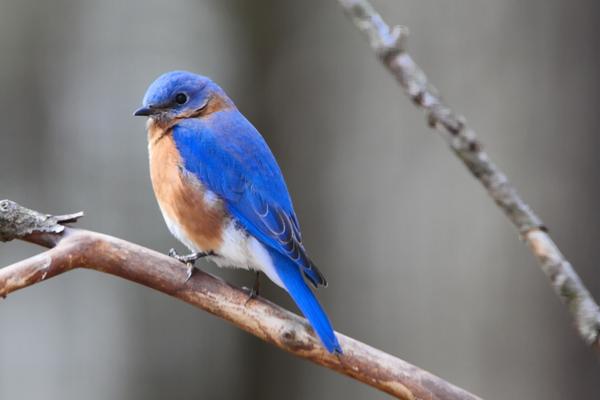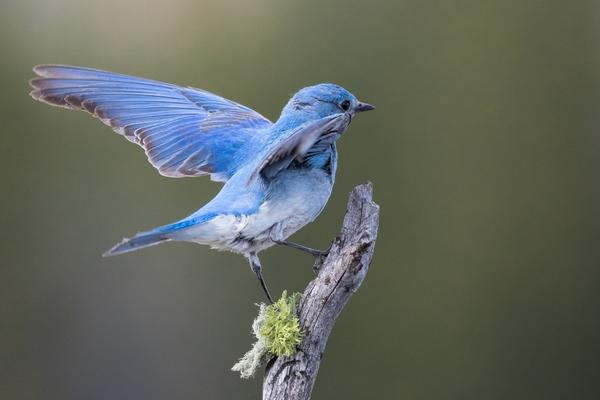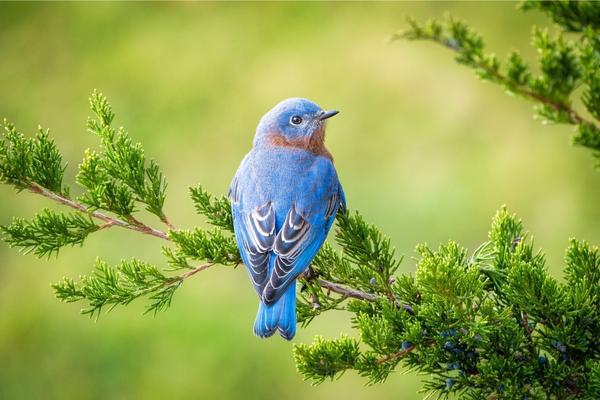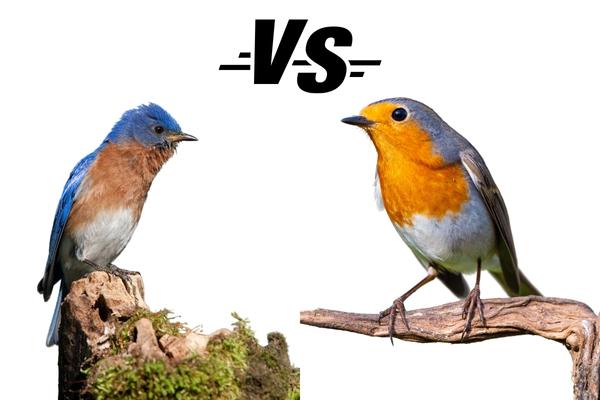All about Birds
Blue Jay vs Bluebird (2023): How To Tell The Difference?
Are you curious about the differences between the Blue Jay vs Bluebird?
In this guide, we’ll explore the various features that distinguish Blue Jays VS Bluebirds, from their appearance and behavior to their habitat and cultural significance.
Get ready to learn all about these fascinating birds and how to identify them!
What’s the difference between Bluebird and Blue Jay?
The bluejay is much bigger than the bluebird, and its call is louder as well.
| Bluebird | Blue Jay |
|---|---|
| Smaller | Larger |
| Reddish-brown breast | Blue crest on head |
| Insect-eating diet | Omnivorous diet |
| Found in open woodlands and meadows | Found in forests, parks, and suburban areas |
| Known for soft, warbling song | Known for loud, raucous calls |
| Scientific name: Sialia | Scientific name: Cyanocitta cristata |
It tends to be more aggressive and territorial when it comes to defending food sources or nesting areas.
Blue jays are also commonly seen in backyards, where they will often steal food from bird feeders.

In contrast, bluebirds tend to stay away from humans and prefer to remain in more natural areas.
Bluebirds are primarily insectivores, while bluejays will eat both insects as well as nuts and seeds.
Both blue jays and bluebirds can be found throughout North America:
But blue jays are more common in urban and suburban environments whereas bluebirds often make their home in more natural areas.
Blue Jay vs Bluebird: Which is bigger?
The bluejay is significantly bigger than the bluebird.
- On average, adult blue jays measure around 9 to 12 inches in length and weigh about 2.4 ounces.
- The bluebird, on the other hand, typically measures between 5 and 7 inches in length and weighs around 0.6 ounces.
In conclusion, bluejays and bluebirds are two distinct species of birds that have unique physical and behavioral differences.
| Bluebird | Blue Jay |
|---|---|
| Smaller, around 6 to 8 inches in length | Larger, around 9 to 12 inches in length |
| Weighs about 1 ounce | Weighs about 3.5 ounces |
| Wingspan of 9 to 12 inches | Wingspan of 13 to 17 inches |
Bluejays are larger, louder, and more aggressive than bluebirds, which prefer to stay away from human dwellings and feed primarily on insects.
Blue Jay vs Bluebird: Which are more common?
It is a known fact that bluejays are much more common than bluebirds, due to their much wider range of environments.
- Bluebirds prefer to live in open woodlands
- Bluejays are much more versatile, inhabiting not just woodlands but also the edges of forests, city parks, and gardens.
However, bluebirds can form large flocks whereas bluejays cannot do the same due to their generally solitary nature:

They communicate vocally with each other though they rarely join in groups while hunting or resting.
The bluebird’s unmistakable song can often still be spotted in the warmer months.
Although bluebirds seem more prevalent on rural roads and country lanes compared to higher population areas.
Differences in size, shape, and color
The blue jay and bluebird, while often confused due to similar colors, have vastly different sizes, shapes, and behaviors.
- While the bluebird only reaches around 7 inches in length when fully grown
- The bluejay is over twice as large with a maximum size of 17 inches.
Additionally, blue jays have unique blue coloring with a darker blue crest and white eye rings along their face.
| Blue Jay | Bluebird | |
|---|---|---|
| Size | Larger | Smaller |
| Length | 9-12 inches | 6-8 inches |
| Weight | 2.5-3.5 ounces | 1-1.5 ounces |
| Wingspan | 13-17 inches | 9-12 inches |
| Shape | Rounder body, larger head, and short neck | Slender body, small head, and thin neck |
| Color | Blue crest on head, blue feathers, white and black markings | Bright blue feathers, reddish-brown breast, white underbelly |
Bluebirds on the other hand are much more uniform in color all around their body, with back feathers, chest feathers, and wings all being shades of blue-gray.
The difference in the sounds they make
The blue jay and bluebird have nuanced yet important differences in the sounds they make.
The blue jay is typically considered to be quite loud, and capable of filling forests with its vibrant and energetic noise.

This sound is not only louder than that made by bluebirds but also more varied:
- Blue jays are known to create a cacophony at times. In contrast
- Bluebirds tend to be rather quiet and soft, their calls rarely traveling far.
Despite this difference in volume level, bluebirds can often still be easily detected due to the distinctive pattern of their songs.
All in all, both species are invaluable for enlivening our outdoors with their unique vocals!
Differences in Nesting Preferences
Bluejays and bluebirds also differ in terms of their nesting preferences:
- Bluejays tend to build nests within trees or shrubs
- Bluebirds typically use cavities within tree trunks or old woodpecker holes.
All these differences result in bluebirds and bluejays often inhabiting different areas while still providing crucial ecosystem services:
- The bluebird’s choice of living arrangement allows it to hide away from predators, as well as make full use of the sun’s warmth in order to incubate eggs.
- Bluejays, on the other hand, are much more open and frequently build their nests close to human dwellings or within large groups of trees.
While bluebirds tend to inhabit more rural areas bluejays have a much wider range and can often be found in urban parks, gardens, or residential yards.
| Difference | Blue Jay | Bluebird |
|---|---|---|
| Nesting Type | Platform nest made of sticks, twigs, and grass in trees, shrubs, or on man-made structures | Cavity nesters that use natural cavities or old woodpecker holes in trees or birdhouses |
| Nesting Height | Usually above 10 feet, but can nest at lower heights, too | Generally below 10 feet from the ground, sometimes on the ground in open areas |
| Nesting Material | Sticks, twigs, grass, and sometimes mud | Fine grasses, pine needles, feathers, and sometimes mud |
| Nesting Season | March through July | Late March through August |
| Number of Broods | Usually one per season, but may have up to three | One to two broods per season |
| Eggs per Clutch | 2-7 eggs, usually 4-5 | 3-7 eggs, usually 3-4 |
| Incubation Period (days) | 16-18 | 12-14 |
| Fledging Period (days) | 17-21 | 17-21 |
Both species of bird are crucial for their respective ecosystems and should be respected no matter the size or the sounds they make.
- Bluejays are more common due to their wider range
- Bluebirds can still be found in rural areas with their unmistakable song.
They belong to different families
Blue jays and bluebirds are a common sight in many parts of the world, but even though they appear to be similar, they belong to different families.
- Bluejays are part of the corvid family
- Bluebirds are members of the thrush family.

Even though bluejays may look like bluebirds and have some behaviors that overlap with bluebirds, they have different nesting habits, diets, and calls:
- Bluebirds prefer open grassland habitats while bluejays thrive in areas with dense foliage and trees.
- Bluebirds feed on insects while bluejays enjoy fruits and peanuts as a snack.
- Also, bluebird songs tend to be flutes or warbles while bluejay songs will include harsher notes.
Differences In Habitat
Blue jays occupy a much wider variety of habitats than bluebirds:
- They live in woods, orchards, farmland, parks, and town gardens.
- By contrast, bluebirds prefer open fields and meadows with scattered trees or shrubs
- An ideal bluebird habitat includes plenty of open space as well as providing insect-rich shrubs and trees to gather food.
Bluebirds crave the long grasses of meaning-type environments while blue jays are more tolerant of wooded areas with denser vegetation.
| Bluebird | Blue Jay |
|---|---|
| Found in open woodlands, meadows, and orchards | Found in forests, parks, and suburban areas |
| Nests in tree cavities or birdhouses | Nests in trees |
| Often found near farmland and pastures | Often found near oak trees and other hardwood trees |
| Prefers nesting in areas with low grass or bare ground | Prefers nesting in dense trees or shrubs |
| Can be found throughout North America, from Canada to Mexico | Can be found throughout much of North America, from Canada to Florida |
This difference in the preferred environment means bluejay and bluebird sightings might be completely predictable based on their familiarity with their terrain.
Reproduction
One of the most significant differences between blue jays and bluebirds is their reproductive behavior.
Bluebirds are monogamous birds and mate for life.
They typically have one mate and raise one brood of chicks per year.
| Difference | Blue Jay | Bluebird |
|---|---|---|
| Mating System | Polygamous, males mate with multiple females in a season | Monogamous, one male and one female mate for life |
| Mate Selection | Males attract females with displays of dominance and by sharing food | Males attract females with songs and displays of nest-building ability |
| Courtship Rituals | Males will bring food to females and perform courtship displays such as puffing out their feathers and bowing | Males will sing to females and perform courtship displays such as carrying nesting material and offering it to the female |
| Incubation Period (days) | 16-18 | 12-14 |
| Responsibilities | Males assist in feeding the young and defending the territory | Females build the nest, incubate the eggs, and care for the young, while males provide food and defend the territory |
In contrast, blue jays are not monogamous and will mate with multiple partners during their breeding season.
Blue jays also typically lay more eggs per clutch than bluebirds, with an average of four to five eggs per clutch compared to bluebirds’ three to four.
Behaviour Differences
Blue jays and bluebirds have distinct behavioral differences as well.
Blue jays are highly social birds and often travel in groups, while bluebirds are more solitary and prefer to stay in pairs.
Blue jays are also known for their aggressive behavior, often chasing away other birds and even squirrels from their territory.
Bluebirds, on the other hand, are peaceful birds and rarely exhibit aggressive behavior.
Nesting
Blue jays and bluebirds also differ in their nesting habits.
Bluebirds are cavity nesters and prefer to make their homes in tree cavities or birdhouses.
They will also use abandoned woodpecker holes or natural tree cavities.
Blue jays, on the other hand, build their nests in trees using twigs, bark, and grass.
Blue jay nests are typically larger than bluebird nests and can be up to a foot in diameter.
Food
Blue jays and bluebirds have different dietary preferences as well.
Bluebirds are primarily insectivores and feed on insects, spiders, and other small invertebrates.
They will also eat fruit, especially during the winter months when insects are scarce.
Blue jays, on the other hand, are omnivores and will eat almost anything, including insects, small mammals, seeds, and fruits.
Gender Roles
Blue jays and bluebirds also have distinct gender roles.
Blue jays are sexually monomorphic, meaning that males and females look alike.
However, during breeding season, males will often exhibit more aggressive behavior and do more of the nest building.
Female blue jays are responsible for incubating the eggs and caring for the chicks once they hatch.
Bluebirds are sexually dimorphic, meaning that males and females have different physical characteristics.
Male bluebirds have brighter blue feathers than females and also have a reddish-brown breast.
Female bluebirds are responsible for building the nest, incubating the eggs, and caring for the chicks once they hatch.
FAQs About Blue Jay Vs Bluebird
Is a blue jay the same as a bluebird?
No, a blue jay and a bluebird are two different species of birds. While both birds have blue feathers, they have distinct differences in appearance, size, and behavior. Blue jays are larger and have a distinctive crest on their heads, while bluebirds are smaller and have a reddish-brown breast.
What does it mean if you have a blue jay in your yard?
If you have a blue jay in your yard, it means that you live in an area where blue jays are common. Blue jays are native to North America and are found in forests, parks, and suburban areas. Having a blue jay in your yard can be a delightful sight, as they are known for their striking blue feathers and their loud, distinctive calls.
Why do people say bluebird?
People say bluebird because it is a species of bird that has bright blue feathers. The Eastern Bluebird, for example, is a small, insect-eating bird that is native to North America. It is known for its beautiful blue color, which has made it a popular subject in art and literature.
Is blue jay same as jay?
Yes, a blue jay is a type of jay. Jays are medium-sized, omnivorous birds that belong to the family Corvidae. Other species of jays include the Steller’s Jay, the Gray Jay, and the California Scrub-Jay.
Is a blue jay a rare bird?
No, blue jays are not rare birds. They are native to North America and are found throughout much of the continent, from Canada to Florida. Blue jays are common in forests, parks, and suburban areas, and are known for their striking blue feathers and their loud, distinctive calls.
What is another name for a blue jay?
Another name for a blue jay is Cyanocitta cristata. This is the scientific name for the blue jay, which is a species of bird that is native to North America.
Is a blue jay a hawk?
No, a blue jay is not a hawk. Hawks are a different type of bird of prey, known for their sharp talons and powerful beaks. Blue jays, on the other hand, are medium-sized, omnivorous birds that belong to the family Corvidae.
What is the official name for bluebird?
The official name for bluebird depends on the specific species of bluebird. The Eastern Bluebird, for example, is known by its scientific name, Sialia sialis, while the Mountain Bluebird is known as Sialia currucoides.
Final Thoughts About Blue Jay Vs Bluebird
In conclusion, while blue jays and bluebirds may look similar at first glance, there are many differences between these two birds.
From their reproductive behavior to their dietary preferences, each bird has its unique characteristics that make it distinct from the other.
So, the next time you see a blue jay or bluebird, take a closer look and appreciate the beauty and uniqueness of each species.

